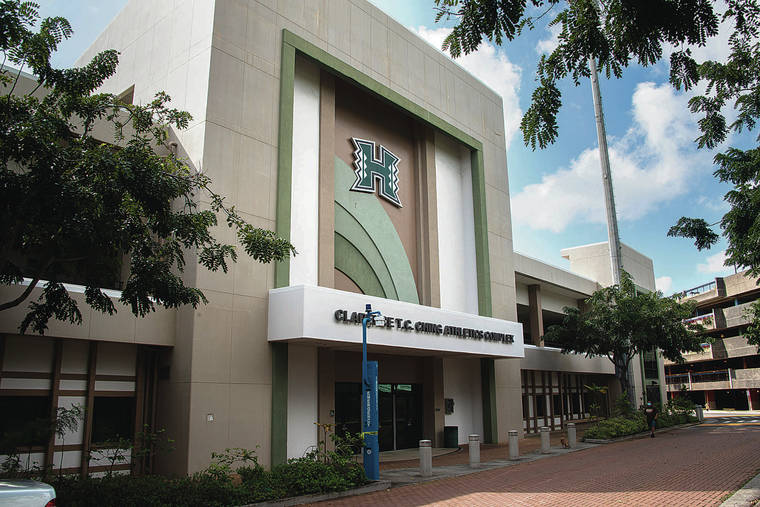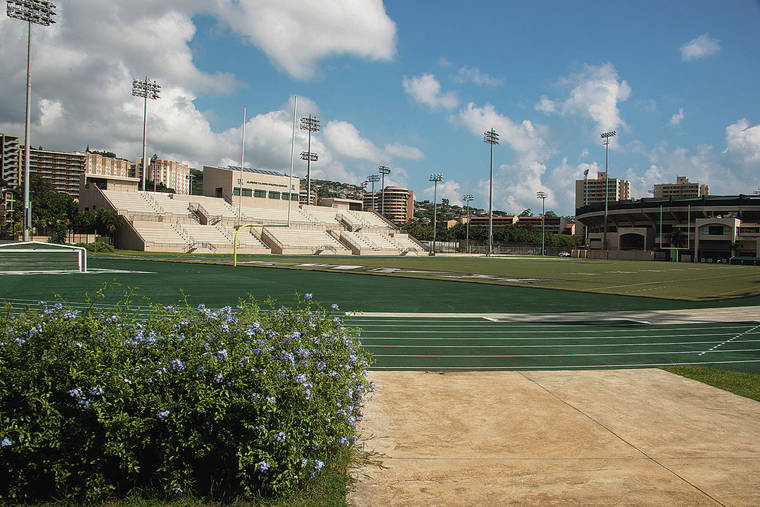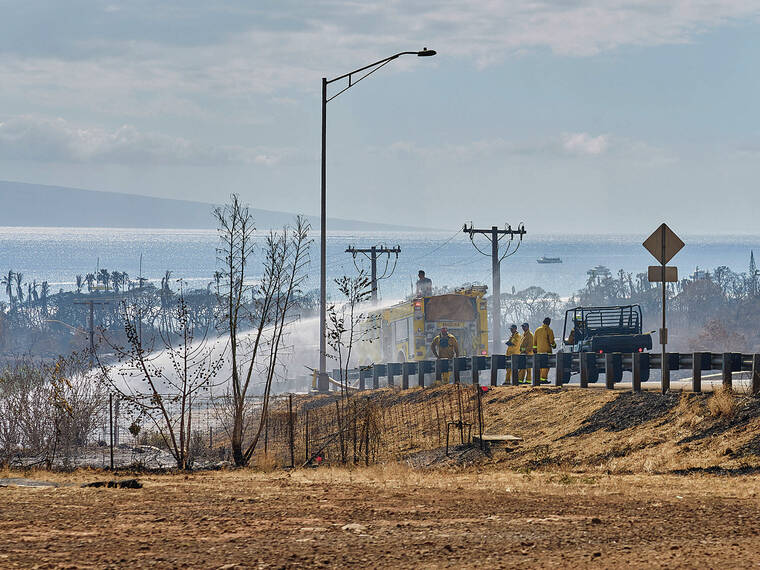University of Hawaii football games in Manoa seen costing $400K annually

CRAIG T. KOJIMA / CKOJIMA@STARADVERTISER.COM
The $6 million retrofitting of the Clarence T.C. Ching Athletic Complex to host Rainbow Warrior football games on the Manoa campus would expand its capacity to 10,000 and would result in an annual net loss of $400,000.

CRAIG T. KOJIMA / CKOJIMA@STARADVERTISER.COM
The $6 million retrofitting of the Clarence T.C. Ching Athletic Complex to host Rainbow Warrior football games on the Manoa campus would expand its capacity to 10,000 and would result in an annual net loss of $400,000.


College football games in Manoa could be a $400,000 annual drain for Hawaii’s public university.
That’s the estimate of expenses exceeding revenues for temporarily shifting Rainbow Warrior football games to the University of Hawaii’s flagship campus from longtime home Aloha Stadium.
UH athletic director David Matlin presented the estimate Thursday to the university’s Board of Regents.
University officials anticipate having to play three seasons of football on campus at a practice facility that would undergo “bare bones” retrofitting, so the financial hit could total $1.2 million and perhaps fall to taxpayers amid a recession and overwhelming state budget crisis.
However, there are concerns that the predicament — touched off in December when a state agency informed UH that using Aloha Stadium won’t be viable until a replacement is built — could last more than three years.
“I would think that eight to 10 years is probably a more realistic range as to when a (new) stadium would be completed,” said regent Benjamin Kudo, a local attorney familiar with land development agreements, construction and bureaucratic government work.
Don't miss out on what's happening!
Stay in touch with breaking news, as it happens, conveniently in your email inbox. It's FREE!
“This particular facility (in Manoa) that we’re considering to be temporary may very well end up to be semipermanent,” Kudo told Matlin and other UH administrators at the regents meeting. “I would err on the side of being conservative with regard to your horizon, and make decisions based on a more conservative horizon rather than an optimistic horizon that obviously has been given to you.”
The Stadium Authority, a state agency, is pursuing replacement of 50,000-seat Aloha Stadium with a new 35,000-seat facility on the same 98-acre site in Halawa by late 2023 in partnership with a private developer not yet selected through a competitive bidding process.
The authority has said football games and other events won’t be viable in Aloha Stadium this year because revenues have plummeted due to COVID-19 and can’t support expenses.
Matlin also said the redevelopment plan now includes demolishing Aloha Stadium next year instead of building a new stadium on the property before demolishing the existing stadium.
Aloha Stadium has been the home field for UH football since the facility opened in 1975.
UH typically receives more than $5.1 million in annual revenue from football games at Aloha Stadium, including $4.4 million from ticket sales and seat premiums, $700,000 from priority parking and additional income from TV, radio and corporate sponsorships.
Matlin said the university is trying to make the best decisions amid a challenging surprise situation.
“Agility is the deal right now,” he said.
UH plans to retrofit its Clarence T.C. Ching Athletic Complex in Manoa at an estimated cost of $6 million to make the facility suitable for 10,000 fans, TV broadcasts and teams.
NCAA rules require Football Bowl Subdivision teams to average 15,000 or more people in actual or paid attendance per home game. However, the rule is not strictly enforced, and it is expected that UH could get an exemption due to the extraordinary circumstance of its stadium being taken away.
The decision to use Ching Field, UH officials said, was made after assessing options that included playing all football games on the mainland, at Oahu high school football fields and at neighbor island venues.
Changes planned for Ching Field include expanding seat capacity to about 10,000 from 3,585, relocating scoreboards and game clocks from Aloha Stadium, adding a locker room for visitors, installing player benches, creating concession facilities, building a press box and bringing in portable bathrooms. Turf will also be replaced, but that was scheduled before the emergency overhaul.
“We’re not really overambitious in what we’re looking to implement for this fall,” UH consultant Keola Cheng told the Manoa Neighborhood Board on Wednesday night. “It’s really like a bare-bones approach. We’re trying to just accommodate the essentials for what the program needs to function in the short term.”
Cheng said the short time period is a major factor, given that UH’s first home game this season is Sept. 4 against Portland State.
“UH was really left with the short end of the stick with regard to trying to plan for this next season,” he said.
Jan Sullivan, a UH regent, asked Matlin whether the retrofit can be done in time.
“I think it’s going to be very hard, but yes,” Matlin replied. “Sometimes failure is not an option.”
Matlin said certain essentials will need to be in place but that there could be some improvements as the season goes on or in following seasons.
UH said an opportunity exists to improve the fan experience, particularly for students who live on or near campus.
Tailgating is an uncertainty. Matlin said there could be a kind of controlled tailgating on adjacent sports fields.
Matlin also said head football coach Todd Graham has ideas on how to engage students on campus for games, which are expected to be played Saturdays.
The university has six home football games this year and six or seven games in the following two years.
Some residents in and near Manoa have concerns about traffic impacts from games, though UH said the envisioned changes shouldn’t result in bigger community impacts than past activities.
Diane Chong, an area resident, said during the neighborhood board meeting that she has been stuck 15 minutes in traffic due to volleyball games at Stan Sheriff Center, which has a 10,300-seat capacity.
“That is going to cause a traffic jam,” she said about football games.
UH has said spring on- campus commencement ceremonies routinely attract about 20,000 people and that on-campus parking can accommodate more than 10,000 fans.
Vince Baldemor, UH associate athletic director for external affairs, also said there have been 14,000 to 15,000 fans on campus at times when volleyball and baseball games happen simultaneously.
Baldemor said football should have less impact.
As for the financial impact, Matlin said UH anticipates earning revenue from games at Ching Field but that expenses are expected to exceed costs by $400,000 a year.
This deficit potentially could be covered by donations, taxpayers, expense cuts, new revenue sources or something else. But it will expand what historically has been an annual shortfall for UH athletics.
UH athletics is expected to have an $8.3 million loss for the fiscal year ending in June, largely because of COVID-19. Losses in past years typically ranged from around $2 million to $4 million. Next year the loss is expected to be $4.9 million, though not all of the football program costs are factored into that.




